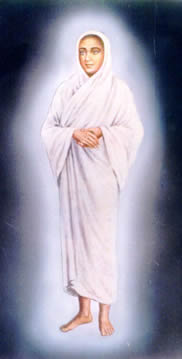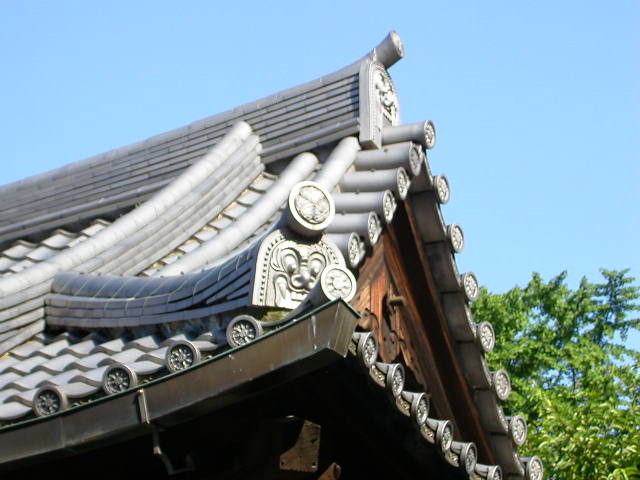|
          |
s a i n t s - o f - i n d i a
VALLALAR ---- Tamil Holyman.
Vallalar (also known as Ramalinga) was instrumental in propogating the Sudha Sanmarga (Pure Gathering) School in the Tamil region of southern India, during the 19th Century. Vallalar belonged to a line of Tamil saints known as "gnana siddhars" ("gnana" means higher wisdom). The Suddha Sanmarga was spread and passed on by him not only in theory but mainly in practice by his own way of living which was itself inspiration for his followers. According to Suddha Sanmarga, the prime aspects of human life should be love connected with charity and spritual practice leading to achievement of pure knowledge. He recommended a rather spartan approach to obtaining Enlightenment -- complete abstinence from sex and the pleasures of the table. In his book Head Itself A Temple, Malaysian-based Tamil Brahmasri Gailasasaamy wrote: "The inner meaning of Sanmarga is Brahma Gnana. One who practices Brahma Gnana can only "Go up"." Let us assume that most people reading this article want to go up -- they want to move up into a higher dimension. Perhaps Vallalar can offer us some insight, perhaps even "The Way". Even though abstaining from sex and even basic human company might be a little too much for most modern Seekers of the Truth!
UNIVERSAL JUSTICE ---- In the Gandhi Tradition.
There have been many books written in Tamil and English about Vallalar. In one of them, The Universal Wisdom of Saint Ramalinga by Dr M.P. Sivagnanam, Vallalar is described thus: "Saint Ramalinga was not only a saint of divine grace but also a reformer who wished for revolutionary changes in society. The socio-religios-economic changes that are taking places in the today's world are the dream of Saint Ramalinga a century ago.  Saint Ramalinga was an even greater reformer than his contemporaries, Raja Mohan Roy, Dhayanandha Saraswathy, and Ramakrishna Paramahamsa. He toiled to find a world of Spiritual Love and Universal Brotherhood, which would be free from the differences of castes and creeds, and such class distinctions as rich and poor, and which will show equal love to all living beings." Saint Ramalinga was an even greater reformer than his contemporaries, Raja Mohan Roy, Dhayanandha Saraswathy, and Ramakrishna Paramahamsa. He toiled to find a world of Spiritual Love and Universal Brotherhood, which would be free from the differences of castes and creeds, and such class distinctions as rich and poor, and which will show equal love to all living beings."
Sivagnanam went on to write: "I desired inwardly that the reformistic ideas of Saint Ramalinga should be propogated in the country, on the basis of piety and patriotism. I also thought of creating a milieu for the birth of a reformistic movement for freeing society from communal and religious fanaticism, transcending hatred towards castes, religion and God." Hence Sivagnanam's efforts to publish a book, to bring the Hindu world back together, under the shadow of Vallalar!

VALLALARS'S THREE RULES ---- Abstinence, Abstinence and Severe Absistence.
Vallalar had many teachings which would be considered obscure today, even anti-social: physical hardship seemed to be high on his agenda! For example, Vallalar belived that initiates should refrain from eating as much as possible, and try to remain perpetually hungry. In fact, Vallalar's great recipe for spiritual enlightenment was thus:
1. Remain hungry.
2. Remain alone.
3. Remain awake
On the issue of sleeping, one of Vallalar's many teachings was that sleeping in the dark causes a loss of Prana (life force, called Chi or Qi in China, Ki in Japan, and "The Force" in Star Wars!) Vallalar wrote: "We should not be in the dark during night. It will cause loss of prana. Therefore, at home, we should sleep having a light, thus removing darkness. This will increase life span. Where there is good lighting, darkness is sucked by such light. If there is no brightness, then such darkness befalls on us and causes losses."
MIND OVER MATTER ---- Vallalar enters the 5th Dimension.
Certainly a strange teaching, but maybe the Illumined Tamil was on to something. According to popular belief, Saint Vallalar finally overcome the restraints of physicality, and entered the 5th Dimension. He did not die as such, but simply vanished from the world. Some believers claim he may be alive today (at least in spiritual form), wandering the expanses of Tamil India. Where is Vallalar claims that the Tamil saint had spent his whole life preparing to convert himself into thin air. "The day was January 30, 1874 and places the courtyard of an old monastery in the quiet village of Village of Mettukuppan near Vadular, Tamil Nadu. A frail looking man with gentle eyes was talking to small gathering of disciples. He was clad in a white place of cloth which covered his head and body together. His face emitted an aura of compassion and humility. Ending the discourse he rose from his from his seat and started walked into the building. The disciples followed him in silence. He walked towards a small room in the back of the building. As he reached the door, he turned and looked at his disciples. Raising his arms in farewell and blessing, he entered the room, closed the door and told them to lock it from the outside. The door was locked with a big padlock. There was no other opening.
"Earlier the saint had told his disciples that he was in the last days of his physical existence and that he would soon pass into the astral world. Now he had secluded himself in final preparation.
"The news that the saint had locked himself up in a room slowly leaked out. There was much excitement because the saint had earlier been talking about the possibility of the living dissolution of his physical body.
"It was already three months when the news reached the government at Madras. Some officials came to investigate. They ordered the door to be opened. To the great wonder and amazement of all that stood around, they found no one inside the room. A thorough inspection of the whole building was made and nothing suspicious could be found. Now it was clear that as proclaimed, the saint had achieved the unachievable. Without discarding his physical body, he had dematerialized."

AGAVAL ---- The Call Divine.
Thiru Arutprakasa Vallalar wrote back in 1974: "This Agaval or Call Divine is the longest poem in Tamil containing 1,596 lines. This outpouring was composed by Vallalar in a single night and at one stretch. This stupendous effort was not due to his material learning or scholarship but through the grace of the Lord. There are many great works in Tamil but none can equal this divine poem in its sublimity.
"Compassion occupies the core place of the Lord. The universe is enlightened by this compassion. Similarly if man aspires for illumination, he must start his quest from within. This practical way called (Anaga neri), is the way of Suddha Sanmarga which leads to Sachidananda. He, who makes his life anew by following this way, finds Arutperunjothi in one and all and paves the way to Universal Brotherhood.
"Any work of divine inspiration needs divine guidance for its interpretation. Mere scholarship and a great knowledge of lexicon are of no use in the interpretation of such esoteric works. One has to reach the ninth plane (the plane of the soul) to find out the true significance of such works.
"The inner guiding Light commanded me on the eve of first of January 1960 to begin this interpretation. A couple of lines were taken every morning for interpretation. The work went on without any break and was finished in 798 days (l596/2) i.e. from 1st January, 1960 to 8th March, 1962. The much feared conjunction of eight planets in Capricorn (makam) took place on February 4th and 5th of 1962, February 4th was a Sunday and also a new moon day.
(Tamil) "Thiraiyelan dhavirthuch chevviyut rangea
(Tamil) Varaiyelam vilanga vayangu sen judarea"
"The above two lines were taken on that day for annotation. It means that all the obstructing veils were removed and the sun rose splendidly on the mountain tops. This has rather a special significance. We can observe the dawn of the divine Effulgence from the position of the middle star poosam in Cancer. We are safe in the hands of the divine light, which guides all the planets, seen in the opposite sign Capricorn, the sea-monster. Westerners were not able to realize this significance because western hemisphere experienced solar eclipse on that day. These are only examples to show how the inner reflects in the outer World.
"The concept of Siva found in the work is refreshingly different from concepts prevalent during the middle ages. It goes back to pre-historical time. Infinite Divine Light was called Siva by the ancient Tamils They also called it as Kandazhi (Tamil). They came to known of it with their mind's eye or third eye. The last level of grace is only revealed now through Saint Ramalinga. Since Tamil language is based on Siva Tatva, it has become a proper medium of expression for divine light. But we must remember that Sivam mentioned here can no religion connotation in it. Arutsivam means Arutperunjothi, Sivam contains three letters. The letter (Si) is the light (va) is the power of grace or compassion and (m) is the life experienced in man. So Sivam means the divine light not only converging into the soul of man but also diverging from there, completely transmuting him into an immortal one in the process.
"In this Agaval, the evolution of the Universe, through the grace of the Lord, is vividly described. Arutperunjothi is evoked in five hundred alternate lines of the couplets. By going through these lines patiently, we will be able to draw inspiration, realize our own identity with the Lord and live in Him..."
Contact the author Rob Sullivan at coderot@gmail.com. Anticopyright September 2009.

|
|
f e e d b a c k
purushottam (purshu@gmail.com)
says: "What a comprehensive view of the gods of india..really enjoyed it. I thank u for the clarity this article has given me in my seeking.
"I used to be a die hard atheist since childhood-praying to Shiva, vishnu, krishna, ganesha, saraswati, hanuman etc. I beleived in ONE omnipotent,omniscient, omnipresent God.
"But my recent experience with a spiritual master and organization took me towards Advaita philosophy-which makes possible the existence of many gods and the god inherent in every one of us. With the possibility of man becoming GOD one day, it has obviated my belief in 'one GOD for all'.
"So my allegiance shifted from Dvaita(dualistic) to the Advaita(non dualistic) shcheme of things, where there is no radical difference between man and god as man is god's low frequency existence,capable of reaching godhood by various means(bhakti,gyan,karma,meditation,etc).
"All this was fine till i realized that this advaita concept of GOD is effectively atheism in the eyes of a monotheist.
"Nevermind, 'reailty is relative'-I said to myself and continued my journey inwards.("One should have the courage of following truth to wherever it takes").
"WIth my beleif in God shaken, I decided to test my second most prized belief-the concept of Atman through the Advaitic Lens...."
JOIN THE CONVERSATION!

What are your thoughts on Hindu gods? Who is your favourite god (the One you worship?) Or are you losing your religion, as the old REM song went?
View Comments
Post Comments
|
|
|
